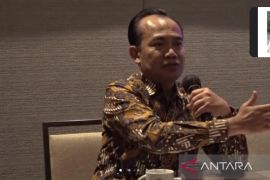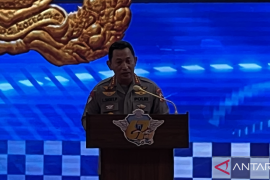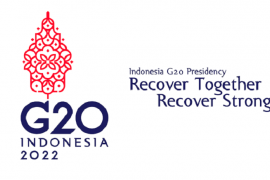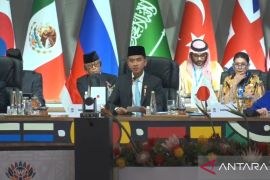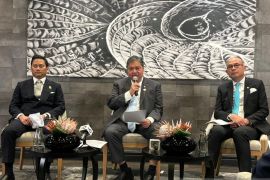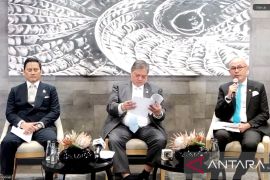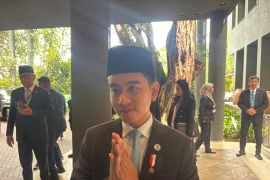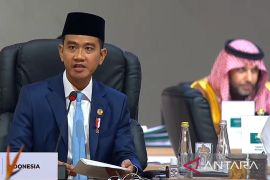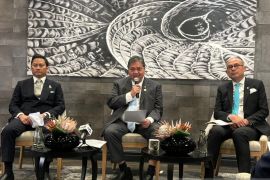On entering the lobby, guests are treated to views of a large fish pond that stretches across the lobby corridors, with special lighting for the night.
Entering a deeper lobby, guests are treated to wide open spaces, high ceilings, wooden pillars carved with Javanese partitions inspired by gebyok and batik stamps from East Java, as well as displays of golden yellow sculpture called Fly High.
The richness of traditional carvings and rare and unique handicrafts is reflected throughout this hotel, not to mention the use of natural colors that create a warm impression and are a visual delight.
The neutral color schemes and textures throughout the interiors of the resort reflect both local materials and diverse signatures of Indonesian craftsmanship.
On the front side of the lobby is a balcony where guests can enjoy views of the sea, cliff edge, coast, and tropical gardens that are soothing to the eyes.
Apurva in Sanskrit means unique and magnificent. One of the architectural features influenced by Balinese culture is the gurgling flow of water on a set of 250 steps located on a cliff.
The water flow system is inspired by the concept of a rice field irrigation system in Bali, or better known as subak. The system describes a harmonious life between humans and the Creator, among humans, as well as humans and the natural surroundings, or better known as the Tri Hita Karana principle.
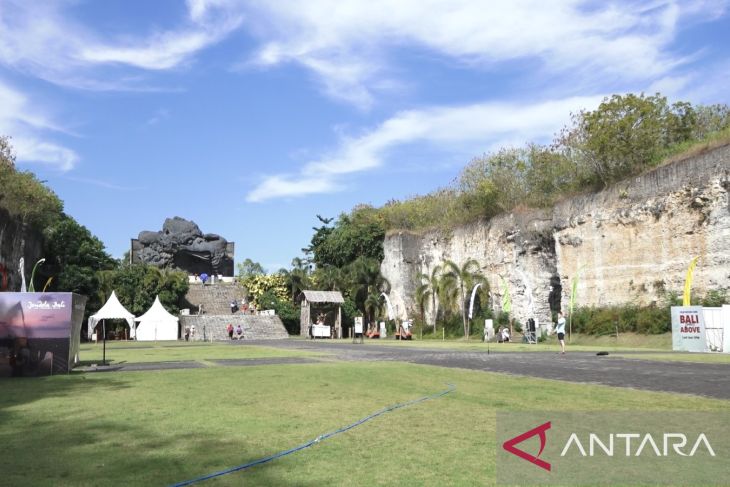
2022 will become another important milestone for the resort as Apurva focuses on celebrating the diversity of Indonesia.
The Unity in Diversity campaign, which will capture the essence of seven main regions of the archipelago: Sumatra, Java, Nusa Tenggara, Kalimantan, Sulawesi, Maluku and Papua, as quoted in the Apurva’s booklet.
These will be part of the guest experience, throughout the resort, including mystical stories, cuisines, craftsmanship, holistic treatments and even traditional family games from the regions.
Throughout the year, there will be distinctive bi-monthly programs, special events, exhibitions and displays by highly-acclaimed artisans.
Each of the resort’s eclectic dining venues will invite guests to explore the traditional dishes of each region, while holistic wisdoms from different destinations will be presented at Apurva Spa. Jalak Family Club will introduce children to the wonders of traditional games.
In addition, the Apurva also has 6 restaurants, including Koral which is the first restaurant under the aquarium in Bali and the second in Southeast Asia.
Guests are invited to an underwater world of bistronomic delights at Koral, the aquarium dining experience at The Apurva Kempinski Bali. All of the senses are stimulated at this unique venue for the very first time.
At Koral, diners will feast on elegant dishes inspired by Indonesian coastal flavours and crafted from local ingredients, at a venue that is both casual and refined.
In addition, Apurva is suitable for holidays with family as the hotel provides playground facilities for children, both in indoor and outdoor areas.
Garuda Wisnu Kencana
Rise from the rugged hills of Bali’s Bukit Peninsula, the magnificent Garuda Wisnu Kencana (GWK) statue stands watch over the island.
The towering statue is Bali’s most iconic landmark and depicts the Hindu God Wisnu, atop his mount, the mythical eagle, Garuda.
The Garuda is the national emblem of Indonesia, an enduring symbol of freedom from oppression, as quoted from GWK’s websites.
Soaring to a height of over 120 meters, this is one of the tallest monumental statues in the world, higher than both the Statue of Liberty and Christ the Redeemer.
The statue makes a stunning central feature of GWK, a fascinating 60-hectare cultural park that draws visitors from around the globe and provides a tantalizing glimpse into Bali’s fascinating heritage through intriguing cultural performances, legendary folklore tales, immense sculptures, and dramatic cinematic presentation.
Enjoy panoramic island views as you explore the park on foot or by Segway. Indulge in Indonesian heritage cuisine, immerse yourself in a land steeped in mythology, or plan your next big event in one of GWK’s epic venues.
Garuda Wisnu Kencana statue depicts Wisnu riding Garuda. In Hindu mythology, Lord Wisnu is seen as the protector of the Universe, while his trusted companion, the mighty eagle-like Garuda represents loyalty and selfless devotion.
Kencana means gold, and both are adorned in crowns of gold mosaic. The Garuda is also the national emblem of Indonesia and represents freedom.
Designed by renowned Balinese artist Nyoman Nuarta, the statue is made of copper and brass and features 754 modules with 25 steel segments weighing in at a hefty 900 tons, with a steel weight of 1300 tons.
The statue and pedestal is 120.9 meters high with a width of 64 meters thanks to Garuda’s wingspan.
GWK Cultural Park Operations Director Stefanus Yonathan Astayasa said that Garuda Wisnu Kencana offered seven venues among others Lotus Pond, Plaza Garuda, Plaza Wisnu, Indraloka Garden, Street Theater, Plaza Kura-Kura, and Tirtha Agung.
Lotus Pond is one of the main venues in GWK Cultural Park. The expansive plaza stretches between limestone walls and is crowned by the statue of Garuda.
This area has good access, incredible acoustics and can hold up to 7,500 people making it a popular choice for concerts and world class events.
The plaza takes its name from the lotus which symbolizes beauty, prosperity and fertility, and is always carried in the hand of Wisnu.
The lotus flower has its roots down in the mud but it blossoms into a magnificent flower above and makes a rich symbol of humanity and the cosmos.
Now, The GWK Cultural Park is preparing the way for the entrance gate, he stated.
"Currently, the road is being strengthened and paved for the entrance. In addition, the entrance gate location will be expanded and beautified with various works of art," he noted.
The Taman Festival ramp will be widened and paved to make it easier for guests, he remarked.
The arrangement of the GWK area, spanning four thousand square meters, will include structuring the Tirta Amertha area, structuring the entrance gate, and sloping the Taman Festival ramp.
The structuring work is targeted to be completed in June 2022.
In addition to facilitating accessibility of visitors from the Tirta Amertha area to the Taman Festival area, the arrangement of the GWK area will support the development of international standard and cultural tourism destinations in Bali.
As the COVID-19 Handling Task Force had decided to ease several restrictions related to COVID-19 handling in Indonesia from Wednesday (May 18, 2022), Bali is expected to revitalize its tourism.
(This story has been updated to rewrite the Apurva and GWK facilities.)
Related news: PUPR Ministry to use bamboos for improving 2022 G20 venues
Related news: Solo chosen as TIIWG venue due to massive industrialization: official
Related news: Government invites media to visit Bali G20 Summit location
Editor: Sri Haryati
Copyright © ANTARA 2022

